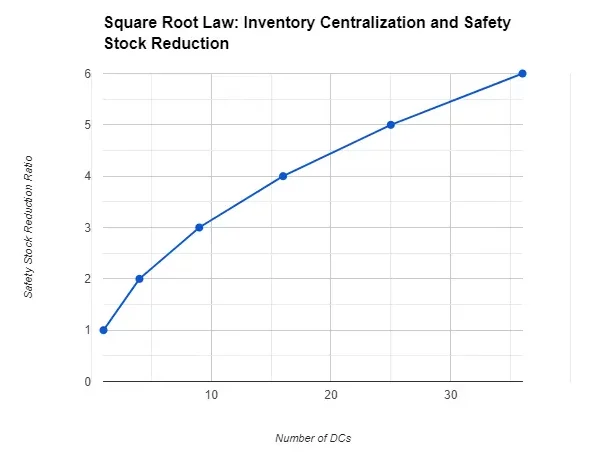Ready to Transform Your Network?
Contact us today to learn more about how our Services can drive success for your business.
Published Aug 2024
Subscribe to receive latest resources on supply chain design
The Square Root Law is a mathematical principle used in supply chain management to explain how inventory centralization reduces safety stock. Here’s a breakdown of the concept and the math behind it:
The Square Root Law provides a formula to estimate the reduction in safety stock when moving from a decentralized system to a centralized one.


Suppose you have 4 decentralized warehouses, each holding safety stock of 100 units. If you centralize this inventory into one location, the new safety stock would be:

This shows a 50% reduction in safety stock due to centralization.
Reduction in Safety Stock:Centralizing inventory leads to a significant reduction in safety stock. This decreases the overall inventory holding costs, freeing up capital and reducing the risk of obsolescence.
Impact on warehousing costs: Centralization reduces the number of warehouses, leading to savings on fixed costs like rent and labor. However the remaining warehouses may need to be larger or more advanced, which could increase costs at these locations. The net impact on warehousing costs depends on the balance between reduced locations and potentially higher costs at central sites.
Increased Lead Times and Service Level Impacts: While centralizing inventory can reduce safety stock, it may also increase lead times to customers. With inventory located further from end customers, the time to fulfill orders might increase, potentially impacting service levels. Companies need to balance the benefits of lower safety stock against the potential cost of slower response times.
Increased Transportation Costs: When inventory is centralized, products often need to be shipped over longer distances to reach customers. This can lead to higher transportation costs, as goods must be moved from a single, central location to various points of demand.
The increased transportation costs might offset some of the savings achieved through reduced safety stock. Additionally, transportation costs can fluctuate with fuel prices and other factors, introducing variability in total logistics costs. Therefore, it’s essential to analyze whether the savings in inventory costs outweigh the potential rise in transportation expenses.
Balancing these factors requires a comprehensive analysis to determine the optimal number and location of warehouses in a supply chain network. Companies might find that a hybrid approach—centralizing certain types of inventory while keeping others decentralized—offers the best trade-off between cost and service.
Contact us today to learn more about how our Services can drive success for your business.
We’re excited to discuss what problems you are facing and how can you make your existing supply chain more efficient by continuously designing it.